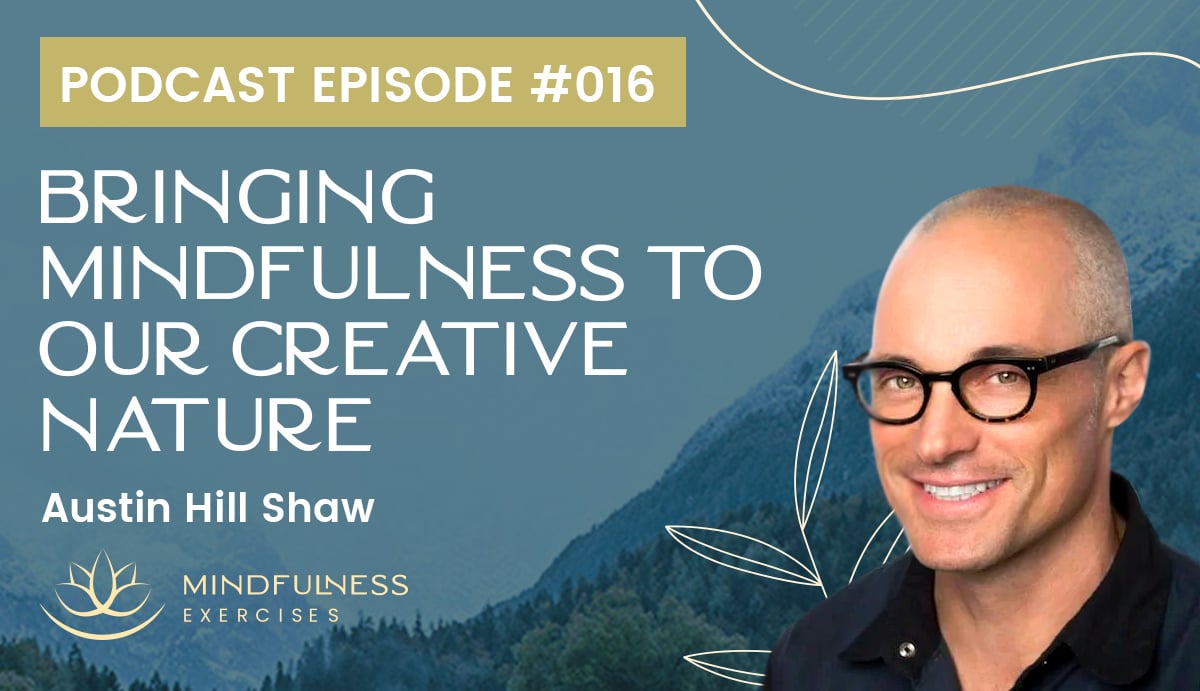Listen now

Do you see yourself as creative? Or do you only associate creativity with art, performance, inventiveness or eccentricity, thinking it has little to do with you?
For author and home designer Austin Hill Shaw, creativity is at the very core of what it means to be human. Creativity matters because people are their happiest and most fulfilled when immersed in creative flow.
In this episode, Sean Fargo, the founder of Mindfulness Exercises, speaks with Austin Hill Shaw on the nature of creativity and how it intersects with our mindfulness and meditation practice.
Sponsored by our Mindfulness Meditation Teacher Certification Program
MindfulnessExercises.com/Certify
Show Notes:
Why creativity matters
Creativity is central to who we are as humans. We have a unique ability to imagine past and future versions of ourselves, and to change our environment by making things. The universal appeal of creativity exists, because we each have the potential to be creative. When we fail to see this potential, we limit our ability to realize it.
“If you’re seeing creativity as being expressed in other people, but not yourself, you might not even engage it, just because you have this belief in your mind that you’re not creative. And so, why does creativity have so much universal appeal? Because we as humans, all of us have the capacity to create.”
Creativity as a means of tending to our deepest needs
When we view the creative process not as an artistic process per se, but as a creative approach to life, we can see how it addresses our core human needs. Austin defines these as the need for connection, the desire to contribute, and the need for meaning. These parallel the creative processes of insight, manifestation and self-expression.
“What is meaningful in creativity, kind of the highest expression of creativity, is what we might call Self-expression. And really I like to think of it as Self with a capital S, meaning it’s the big knowingness that’s connected to the universe that’s being channeled through our finite movements and decisions and all the things that we do.”
The intersection between creativity and meditation
When we perceive meditation as an active, creative process, our perception of what meditation can do for us changes. Austin explains how the three Buddhist vehicles of Hinayaya, Mahayana and Vajrayana relate directly to unfolding creativity. As we move from gross level confusion to a worldview that infuses mindfulness into each moment of our daily lives, we step into our most authentically creative selves.
“Finally, in the Vajrayana, as opposed to keeping things out in the world, including difficult news, difficult people, difficult situations, challenges, we get this courage to take things on and say, ‘Ok, I’m going to take a stand for my healing, I’m going to make a stand for my family’s healing, I’m going to do what I can to work with the greater earth,’ or whatever it is that you’re up to. That starts to become the indestructible path because you’re infusing your daily life and your activities with a mindfulness practice, with a way of looking at the world that neither solidifies it, nor steps out of it entirely.”
Living in wonder
With mindfulness, we’re invited to drop the duality of judgment and enter an open space of curiosity and wonder. We’re asked to position ourselves between ignoring what’s arising and becoming overwhelmed by it. This in-between space of wonder may be explained as the space between undescribable insight and the creative process itself. Getting to this wondrous space becomes a co-creative process when we allow the world to teach us.
“We can start to get out of this sort of knee-jerk reactive way of working with our mind and get into a space that is really, genuinely creative because we’re in a space of curiosity, because we’re in a space of wonder. And we’re allowing the world to teach us and inform us. It becomes a co-creative process.”
What it means to feel joyful
Mindfulness strengthens our ability to discern between happiness and joy, connecting strongly to the latter. With mindfulness, we can learn to be present, to feel at home and steeped in love, no matter what. This may be our greatest act of creativity.
“What you get to see [with mindfulness] is the contents of your mind. And that acceptance is joyful.”
Resources

About Austin Hill Shaw
Austin Hill Shaw is an author, teacher, speaker, coach, entrepreneur and home designer. No matter how he’s working, his mission is to empower others to create. His books include “The Shoreline of Wonder: On Being Creative” and “Between the Bridge and the Water: Death, Rebirth, and Creative Awakening.” His design firm, 3 Lights Design, is a San Francisco Bay Area-based residential and commercial design collective. Their unique, mindful approach to home design educates and empowers clients to become joyful co-creators.



